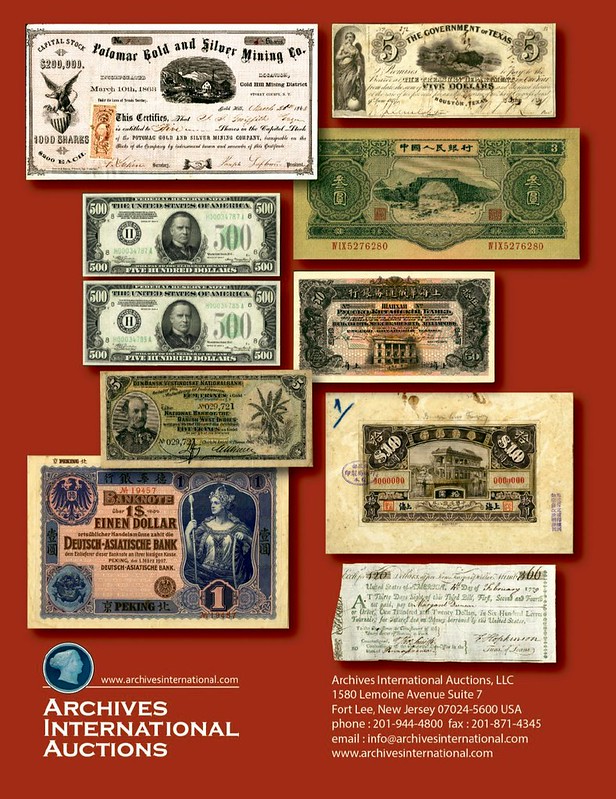
PREV ARTICLE
NEXT ARTICLE
FULL ISSUE
PREV FULL ISSUE
SELECTIONS FROM THE SHAW & BETTENCOURT SALEBeginning March 29, 2017 Stack's Bowers will offer the Dr. Gordon Shaw & Anthony Bettencourt sale. Here are some lots that caught my eye for various reasons. -Editor
Lot 8: Libertas Americana Medal
 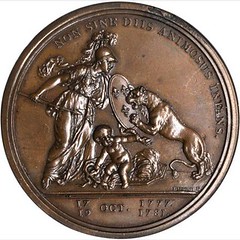 "1781" (1782) Libertas Americana Medal. Bronze. 47 mm. By Augustin Dupre. Betts-615. MS-62 BN (PCGS). Only about 100 to 125 or so examples are known in bronze, and they vary in grade from well worn to Gem Mint State, with the present piece residing comfortably among the nicer specimens. There is perhaps no medal or coin that speaks so loudly about the birth of the United States of America than the Libertas Americana medal. Designed by Augustin Dupre in Paris in 1782, this beautiful type was instigated by Benjamin Franklin, then minister to France and representative of the newly proclaimed United States of America. The most prominent feature for history buffs is the date below Liberty's bust on the obverse -- 4 Juil 1776. The head of Liberty facing left on this famous rarity with her cap on a pole inspired the earliest U.S. Mint engravers to make the liberty cap motif part of our nation's first coinage in 1793. Dupre's design is about as beautiful and intricate as a medal can be, especially on the reverse. The intricate interplay between the reverse features is laden with iconography. An infant Hercules representing the new American nation strangles two serpents that represent the British armies at Saratoga and Yorktown, the beginning and end of struggles during the Revolution. France, here depicted as Minerva, holds a shield above the infant and her spear keeps the British lion at bay; the lion's tail between its legs is a symbol of England's defeat. Dates in the exergue, October 17, 1777 and October 19, 1781, represent the dates of the American victories at Saratoga and Yorktown. As often as this medal has come up for discussion, it never gets old. It's an absolute classic and historically important. -Editor
To read the complete lot description, see:
Lot 24: Charleston Company of Volunteers Medal
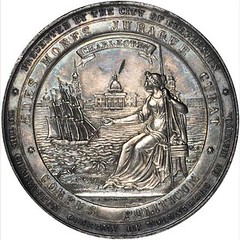 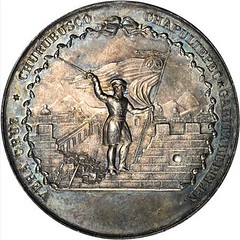 Undated (Circa 1848) Charleston Company of Volunteers Medal. Silver. 56 mm. 74.6 grams. By Charles Cushing Wright. About Uncirculated. Obv: Liberty welcoming a returning ship. Legends include PRESENTED BY THE CITY OF CHARLESTON / TO THE CHARLESTON COMPANY OF VOLUNTEERS IN MEXICO. Rev: Soldier holding a flag and an upright sword standing atop the damaged Garita de Belen in Mexico City. Names of battles around VERA CRUZ CHURUBUSCO CHEPULTEPEC GARITA DE BELEN. An unnamed specimen without the usual mount -- and no evidence of one ever having been removed. Anything by engraver Wright is a special item. Excellent medal and rarely seen (by me, anyway). -Editor
To read the complete lot description, see:
Lot 50: Washington Manly Medal
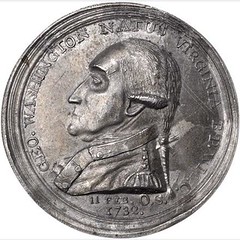 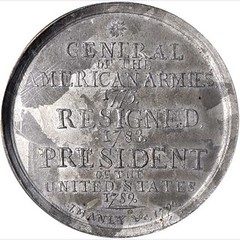 "1790" (Circa 1858) Washington Manly Medal. Second Obverse. White Metal. 48 mm. Engraved by Samuel Brooks, for James Manly. Baker-62A, Musante GW-11. MS-62 (NGC). An especially rare variant of this historic medal. Utilizing the original reverse combined with an obverse very similar to the original, apparently by engraver Brooks' own hand, but with a varying inscription encircling Washington's bust. This type is inscribed GEO. WASHINGTON NATUS VIRGINIA, as contrasted to GEO. WASHINGTON BORN VIRGINIA as seen on the "originals." This type also includes the additional inscription BP WM. C. (Birthplace Westmorland County) which does not appear on the earlier type. Finally, the inscription S. B. F. / 11 FEB. O. S. / 1732 appears on the truncation and below the bust in place of a simple date as on the original type. Minor die crumbling is noted on the rim near 12 o'clock on the obverse, and a die crack extends from there to the top of Washington's head, progressing through the S in NATUS. According to both the Rulau-Fuld and Musante Washingtoniana references, there are only two white metal impressions of Baker-62A known A very nice example. -Editor
To read the complete lot description, see:
Lot 67: 1861 U.S. Mint Oath of Allegiance Medal
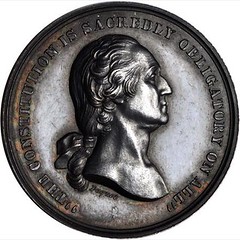 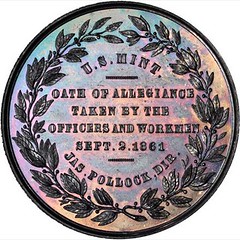 1861 U.S. Mint Oath of Allegiance Medal. Silver. 31 mm. 17.5 grams. Baker-279, Musante GW-476, Julian CM-2. Thick Planchet. About Uncirculated. Deep steel gray on the obverse with golden highlights around the peripheries, the reverse in a similarly deep color, but with glorious electric blue, fuchsia and golden undertones in abundance. A lovely example of this historic Mint medal, struck in commemoration of the Mint's employees having taken an oath of allegiance to the United States upon the outbreak of the Civil War, but reported by Julian to be nothing more than an opportunistic medal devised by Mint Director James Pollock to take advantage of the demand for Washington medals. The thicker strikes, as seen here, are believed to be the earliest. Mint records show that 51 examples were struck in silver in 1861. By the end of the 1860s, the demand had dropped considerably and striking was sporadic and limited, but the total in silver had reached 259 specimens by 1904. Copper impressions are common but nice silver examples, as here, are scarce and eagerly sought by collectors. Another Washington item, and a curious relic of Civil War politics. Gorgeous reverse toning. What a great medal! -Editor
To read the complete lot description, see:
Lot 80: 1913 Better Babies Medal
  1913 Better Babies Medal. Gold. 34 mm. 32.76 grams. By Laura Gardin Fraser. AU-50 (ANACS). Obv: Two cherubic babies beneath the inscription BETTER BABIES. Rev: Inscribed BETTER BABIES MEDAL / AWARDED BY / THE / WOMAN'S / HOME COMPANION, below which is a cartouche engraved NETTIE DIXON ROBERTSON / MONTGOMERY, ALA. / 1913. At the bottom of the reverse is LAURA GARDIN / SCULPTOR. The edge is plain except for ©1913 at the bottom. A tiny test mark visible through the edge of the slab at 3 o'clock (as mounted by ANACS) is not easily detected and does not detract from the medal. Issued sporadically for about 10 years after the initial release in 1912, this medal is occasionally encountered in bronze (in a larger 51 mm format), but exceedingly rarely in gold. No other gold issues are presently accounted for other than one awarded in 1922, that was sold by Presidential Coin and Antique Co. in 2001. This specimen, issued in 1913, was engraved by Laura Gardin just before her marriage that year to James E. Fraser, of Buffalo nickel fame. Between the two, many notable numismatic items were produced, as well as statuary in both life and heroic size. Nettie Dixon Robertson (1912-1992), the recipient of this particular medal, lived all her 80 years in the South, marrying at 26 years of age in 1938. We've discussed this one before. See the links below for earlier articles. Great opportunity to acquire a nice example. -Editor
To read the complete lot description, see:
To read the earlier E-Sylum articles, see:
Lot 120: 1881 ANS Cleopatra's Needle Medal
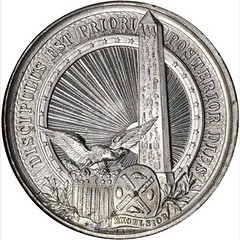  1881 American Numismatic Society Cleopatra's Needle Medal. White Metal. 41.2 mm. Miller-5, Johnson-Unlisted. Prooflike Mint State. Obv: Eagle over Federal and New York City Arms gazes toward a towering obelisk against a radiant field. Rev: Eleven-line inscription recording the obelisk's erection by Pharaoh Thothmes III at Heliopolis, relocation to Alexandria by Roman Emperor Augustus, and transport to New York in 1881. Egyptian Khedive (Viceroy) Ismail (Ismael Pasha 1830-1895) presented this obelisk to the United States and a group of wealthy New Yorkers led by William H. Vanderbilt financed relocation of the multi-ton ancient stone relic to New York City's Central Park. Still housed in a pristine descriptive presentation folder personally inscribed on the back to the New York Produce Exchange on June 1, 1882 from noted Lincolniana collector Robert Hewett, Jr., second vice president of the ANS at that time, and a member of the committee responsible for the medal. Hewett is primarily remembered today as the founder of The Circle Of Friends Of The Medallion which produced America's first series of art medals. This medal and its folder are in remarkably well preserved. This lot also includes what is apparently the top and bottom of the cardboard box in which the folder was originally housed. The top is
embossed DEMPSEY & CARROLL / ART STATIONERS / 46 EAST 14th STREET / UNION SQUARE / NEW YORK. / STORE OF THE MERIDEN CO. (Total: 4 items)
Nice medal, not often seen. We've discussed this one before, in David Alexander's review of Scott Miller's book on the Medallic Art of the American Numismatic Society,
1865-2014. -Editor
To read the complete lot description, see:
To read the earlier E-Sylum article, see:
Lot 209: 1786 Non Vi Virtute Vici Copper
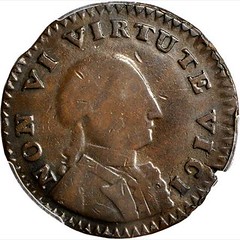 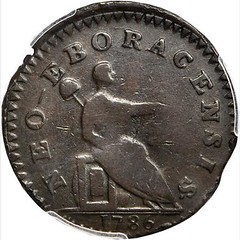 1786 Non Vi Virtute Vici Copper. Baker-13, Musante GW-07, W-5730. Rarity-6. Small Head. VG-10 (PCGS). CAC. PCGS has certified just seven of these, in grades ranging from VG-10 (the present coin) to MS-61; the others are in VF-20, VF-25, VF-30, and (2) EF-40. The Mills-Jenks-Eliasberg Mint State example seems to be the best of the survivors, which probably number somewhere around 25 or 30 pieces in all grades. Several are impounded in places like the ANS, Colonial Williamsburg, and the Boston Museum of Fine Arts. This example is at once more worn and more pleasing than a typical specimen. Though a bunch of these were offered in the 1970s, few have been sold at auction in recent years. Since our (Stack's) 2004 Ford sale, we count just four discrete specimens coming to market: the F. Dabney Caldwell specimen, the Eric P. Newman specimen, the Jack Royse specimen, and the present example formerly part of the Henry P. Kendall Foundation Collection. A rare type steeped in mystery, the Non Vi Virtute Vici coppers are of unknown origin and intent, although they have long been associated with attempts by several individuals to obtain rights to coin coppers for the State of New York (all of which failed for the state legislature never authorized an official coinage). The reverse of these enigmatic pieces bears the inscription NEO - EBORACENSIS, which is similar to the obverse inscription of the Nova Eborac coppers likely produced by John Bailey and Ephraim Brasher in or near New York City. Washington again. I don't think I've ever seen one of these in person. -Editor
To read the complete lot description, see:
Lot 376: Albany Church Penny
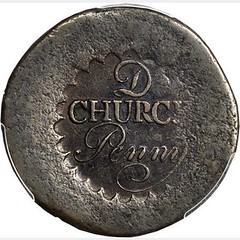 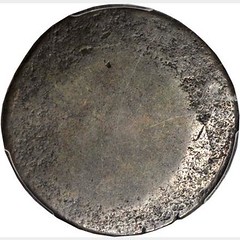 Undated (1790) Albany Church Penny. W-8500. With D Added. EF-40 (PCGS). CAC. 121.3 grains. A beautiful example of the most popular American communion token, struck over a very well worn English halfpenny that was still circulating in the Hudson Valley a century after it was made. A particularly fine example. In our (Stack's) Ford II sale of 2004, we offered specimens of both with D and No D varieties. The With D brought more than the No D, but perhaps not enough more to give this variety its proper premium for rarity. Long assumed to be of about the same rarity, it actually looks like this variety is the rarer of the two by a significant margin. Michael Hodder recorded just five specimens known to him: the Ford coin, boldly overstruck on a George III counterfeit halfpenny; a specimen in the Partrick collection; one in a well known Rhode Island collection, also overstruck on a George III counterfeit halfpenny; the Robison-Roper coin; and the Picker coin. We can add two to the list, aside from this one. The Breen plate coin for this variety is pedigreed by Breen to a "Pvt. Coll.," but it's actually the ANS coin, ex Howland Wood, and has been there since 1911; it is the only Albany Church penny in the ANS holdings. There was also a newly discovered specimen, a very nice one, sold in Heritage's January 2012 sale for $115,000. That one, like this coin, was struck over an extremely worn William III halfpenny; it was graded PCGS EF-45+. Since Ford, the Ford specimen has resold in the Heritage January 2007 sale, now graded PCGS VF-35, at $74,750. Other than the present example, we have sold two Albany Church pennies since Ford, though both were the No D variety: one in our (Stack's) 2009 ANA sale graded VG-10 (NGC) and another in our November 2011 sale graded Fine-15 (PCGS) that was boldly overstruck on a (likely counterfeit) 1771 English halfpenny. PCGS has graded an example of this variety on five occasions, though we believe this total to represent at most four specimens, and more likely three. One of my favorite colonial coins, after the Higley copper. -Editor
To read the complete lot description, see:
Wayne Homren, Editor The Numismatic Bibliomania Society is a non-profit organization promoting numismatic literature. See our web site at coinbooks.org. To submit items for publication in The E-Sylum, write to the Editor at this address: whomren@gmail.com To subscribe go to: https://my.binhost.com/lists/listinfo/esylum All Rights Reserved. NBS Home Page Contact the NBS webmaster 
|
